 |
Classic French plugs and sockets |
|
Porcelain
and Duroplast sockets that were produced in France in the 1920s to
1970s are shown here. Each have the standard continental European
spacing for line and
neutral slots of 19 mm.
A remarkable feature of some models is a fuse integrated in the socket. Fused socket have been used in the 1950s-'70s, probably to limit the inconvenience of a blown fuse to a single socket. |
Related
gallery: classic heavy duty types |
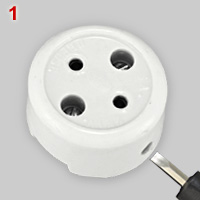 |
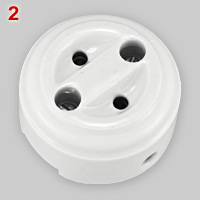 |
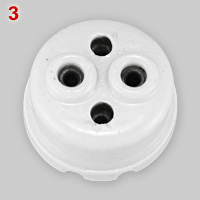 |
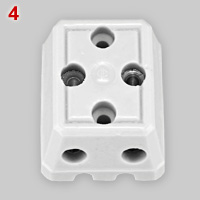 |
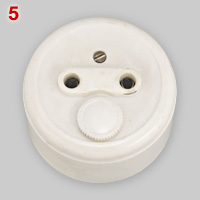 |
 |
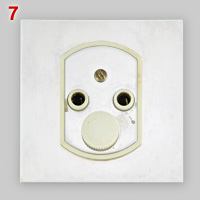 |
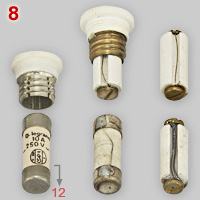 |
| 1-3 | Porcelain,
non-earthed sockets. No. 1 is rated at 5A - 250V. No rating is
indicated on nos. 2 and 3. Slots are designed for 4 mm pins. Nos. 1 and
2 have side entry holes for a screw driver to wire the
socket. None of these sockets have a brand name.
(1):{FB} |
| 4 | Triple, non-earthed porcelain socket, without rating. The socket has been produced by the Legrand company in Limoges; see logo b depicted in image no. 15. |
| 5, 6 | Duroplast, non-earthed socket with fuse, rated at 10A - 250V. Brand name: Electro Sécurit, Antibes. |
| 7 | Fused, non-earthed socket, mounted on a nickel alloy plate, which gives it a silvery look. Brand name: Electro Sécurit, Antibes. |
| 8 | Fuses used in socket nos. 6, 7, 10, 11 and similar models. Most sockets had rewirable fuses. Fuse wires existed for ratings between 5A and ca. 30A. The thick wire of fuse bottom right is an example of a high(er) amperage fuse (25A?); the thin wires of three other fuses are probably rated at 5A. The bottom left 10A cartridge fuse was used in a relatively modern CEE 7/5 type socket (see nos. 11-12). Typical fuse sizes are: length = 22.5 mm, diameter of ceramic part = 8 mm. |
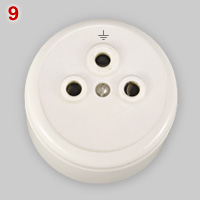 |
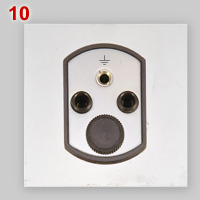 |
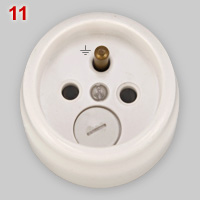 |
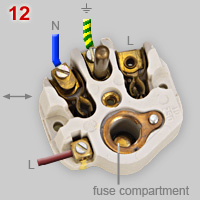 |
| ↑ | ←
↑ |
||
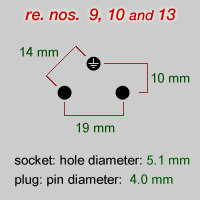 |
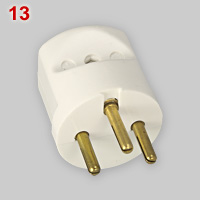 |
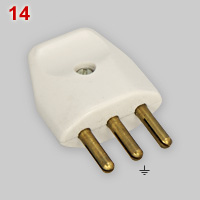 |
 |
| Intro | In
1935 France enacted a decree for workers using electrical equipment. It
was compulsory to use outlets with an earthing device for the use of
electrical appliances with flexible cords. From the mid 1930s three types of earthed sockets an plugs could have been used: (1) German Schuko (now CEE 7/3-7/4); they were offered by the French company Appareillage Electrique Maure; (2) French 3-pin type shown in image nos 9, 10 and 13; (3) sockets with an earth pin (no. 11) and matching plugs, however it questionable whether this (Belgian?) type was available in France before the mid 1950s, when French standard NF C 15-100 was introduced (now CEE 7/5-7/6). Find additional information on the page about domestic earth pin sockets. |
| 9, 13 |
Earthed,
6A - 250V socket and matching plug. The socket has a porcelain body.
These duroplast models were made by Legrand, probably in the (early?)
1950s.
Essential dimensions are
given in the bottom left scheme. Sockets have also been made by French companies L'Ébénoïd and Electro Sécurit, but not by Appareillage Electrique Maure. It is interesting to note that the old Greek Tripoliki system has exactly the same configuration and dimensions as nos. 9 and 13. |
| 10 | Fused,
earthed socket rated at 10A - 250V, comparable to the non-fused socket
no. 9. As no. 7 the socket is mounted on a nickel alloy plate. Brand name: Electro Sécurit. |
| 11, 12 | Fused
socket with earth pin, rated at 10A - 250V. Image no. 12
shows the porcelain body. The fuse is
shown in image no. 8 (bottom left). Holes of L and N pins have a
diameter of 5.7 mm. Earth pin has a diameter of 4.8 mm and is 15 mm
long. Dimensions are comparable to modern CEE 7/5 sockets. Brand name:
Legrand. Note that the integrated fuse is not a part of the CEE 7/5 standard. |
| 14, 15 | Italian (CEI 23-50) type plug and connector, rated at 6A - 250V. This type was common in houses that became French territory after World War II*. French connector plugs have a protruded position of the earth contact compared to power contacts. This feature ensures that earth contact is made first. Italian connector plugs do not have this safety feature. Brand name: Legrand. |
| note |
* Parts of the County of Nizza have swapped several times between Italy and France. The Treaty of Peace with Italy in 1947 allocated Tenda and Briga to France (now Tende and La Brigue in the extreme southeast of France). Source: Dominique Colson, personal communication. |
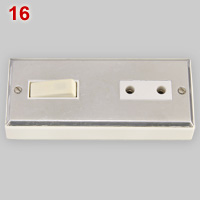 |
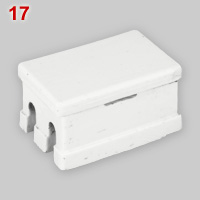 |
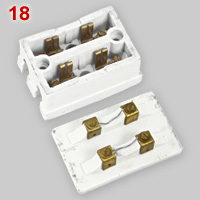 |
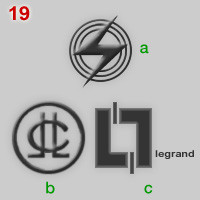 |
| 16 | Legrand series 'Mistral'
socket with switch. Ratings: 6A-250V (outlet) and 10A-250V (switch).
Dating: ca. 1970s. The cover plate has been made of a nickel alloy.
{DH} |
| 17, 18 |
Instead
of fused sockets also separate fuse holders were used in French houses.
Rating of the fuse wires is not indicated. Porcelain fuse holders
existed for both one and two fuses. No brand name
indicated. {FB} |
| 19 | Logos of
two French electrotechnical companies. a: Electro Sécurit, based in Antibes. In 1956 the company has been taken over by Legrand, and renamed to Legrand, Antibes. b: Logo of the Legrand company* as used from 1925 to 1967. CLL = Compagnie Legrand Limoges. c: Legrand logo from 1968 to 1973. The two L's of the previous logo are placed facing each other head-to-foot in combination with two lines to represent a switch with its incoming and outgoing wires. Initially the name 'legrand' was added in small lettering, but later enlarged to the same height of the light-switch type logo. * The Legrand company was established in 1904. It was the successor of a porcelain tableware company founded in 1865 in Limoges by Henri Barjaud de Lafond and Léonard Clidasson. After many acquisitions, in 2011 Legrand became the largest globally for switches and sockets. The head office of the Legrand Group is still located in Limoges. |
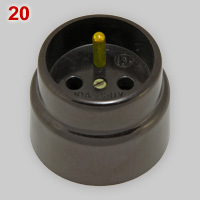 |
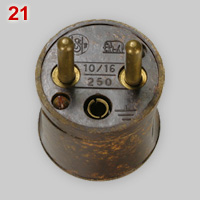 |
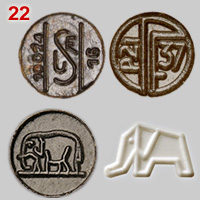 |
| The Compagnie Legrand in Limoges was (and
still is) the largest manufacturer of plugs and sockets in France, but
other producers exist(ed). Among others L'Ébénoïd in Saint-Priest (69).
From 2001 L'Ébénoïd belongs to the Asea Brown Boveri (ABB) group.
Examples are shown in images 20 - 22. |
|
| 20, 21 |
Bakelite socket, rated at 10A - 250V, and
plug rated at 10 (DC) / 16 (AC) - 250V. Manufacturer: L'Ébénoïd.
Dating: 1950s-'60. {WN} |
| 22 | Marks found on Bakelite plugs and socket
made by L'Ébénoïd. • Top left: certification mark issued by the l'Union des Syndicats de l'Electricité (USE). These marks have been used from 1924 until 1947, but it is likely that Bakelite moulds with an USE mark have been used for many more years. • Top right: Plastique Français marque de Qualité, created in 1942 by the Centre d'´Etude des Materières Plastique. From 1946 quality testing of phenoplast and aminoplast resins and products was done by Union Technique de l'Electricité (UTE) in Paris. → Click for details about French certification and Bakelite quality marks. • Bottom left: L'Ébénoïd logo found on classic plugs and sockets. • Bottom right: restyled logo that is used on more modern L'Ébénoïd products. It is unclear when the new logo was introduced. |
| Classic
French three-phase plugs and sockets Find more examples of classic French material in the section on heavy duty plugs and sockets. Click here for three-phase examples. |
 |